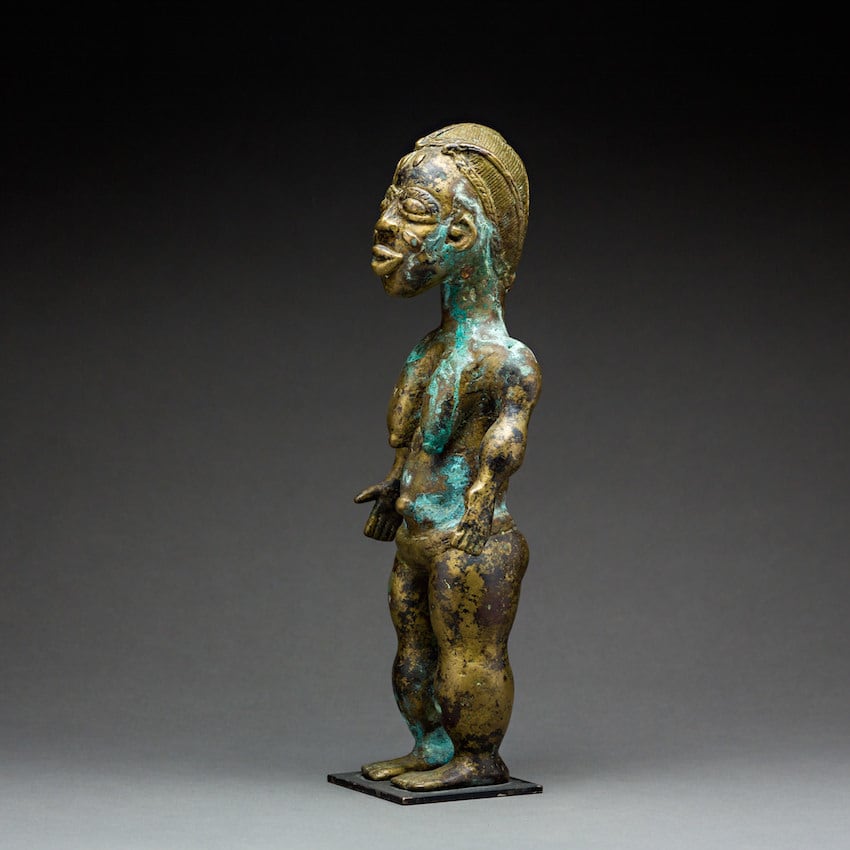Dan Brass Sculpture of a Woman, 19th Century CE - 20th Century CE
Brass
35.6 x 12.7 cm
14 x 5 in
14 x 5 in
PF.5841
Further images
Like the gold weights of the Akan peoples and the heddle pulleys of the Baule and Senufo tribes, the bronze figures of the Dan are considered to be the exceptional...
Like the gold weights of the Akan peoples and the heddle pulleys of the Baule and Senufo tribes, the bronze figures of the Dan are considered to be the exceptional case in the corpus of African art: art objects created for art’s sake. Void of any religious significance or ceremonial function, these realistically crafted sculptures were used by chieftains as purely decorative objects. The chieftain took pleasure in them as they are, appreciating the extraordinary beauty of the objects and the inherent skills of the craftsmanship.
This sculpture of a female, standing stiffly with her arms held at his sides, bears the stylistic signatures of Dan figurative art including the bulbous limbs, planar feet and hands, and the almond-shaped eyes. There is also a relative emphasis placed on the lower half of the body that is rendered much thicker and heavier than the upper portion that is typical of the Dan. There is evidence of ritual scarification on her cheeks and forehead, resembling coffee beans, probably acquired during an initiation ceremony. These scars were inflicted upon the body as marks of beauty that reveal the stature and standing of this woman. Her head is crowned by an elaborate triple-crested hairstyle that further enhances the sense of her physical beauty. Her large sagging breasts are exaggerated in order to enhance her fertility. Over the years, the bronze has acquired a rich green patina in certain places that contrast quite elegantly to the golden hue of the metal. Such a splendid masterpiece of sculpture needs no ceremonial or religious purpose to achieve its power. The force of this artwork is the art itself and the hand of the sculptor. Originally, this work was coveted as an object of beauty by chieftains of the Dan tribe. Today, we appreciate this same striking beauty much as the chieftain would have almost a century ago.
This sculpture of a female, standing stiffly with her arms held at his sides, bears the stylistic signatures of Dan figurative art including the bulbous limbs, planar feet and hands, and the almond-shaped eyes. There is also a relative emphasis placed on the lower half of the body that is rendered much thicker and heavier than the upper portion that is typical of the Dan. There is evidence of ritual scarification on her cheeks and forehead, resembling coffee beans, probably acquired during an initiation ceremony. These scars were inflicted upon the body as marks of beauty that reveal the stature and standing of this woman. Her head is crowned by an elaborate triple-crested hairstyle that further enhances the sense of her physical beauty. Her large sagging breasts are exaggerated in order to enhance her fertility. Over the years, the bronze has acquired a rich green patina in certain places that contrast quite elegantly to the golden hue of the metal. Such a splendid masterpiece of sculpture needs no ceremonial or religious purpose to achieve its power. The force of this artwork is the art itself and the hand of the sculptor. Originally, this work was coveted as an object of beauty by chieftains of the Dan tribe. Today, we appreciate this same striking beauty much as the chieftain would have almost a century ago.







